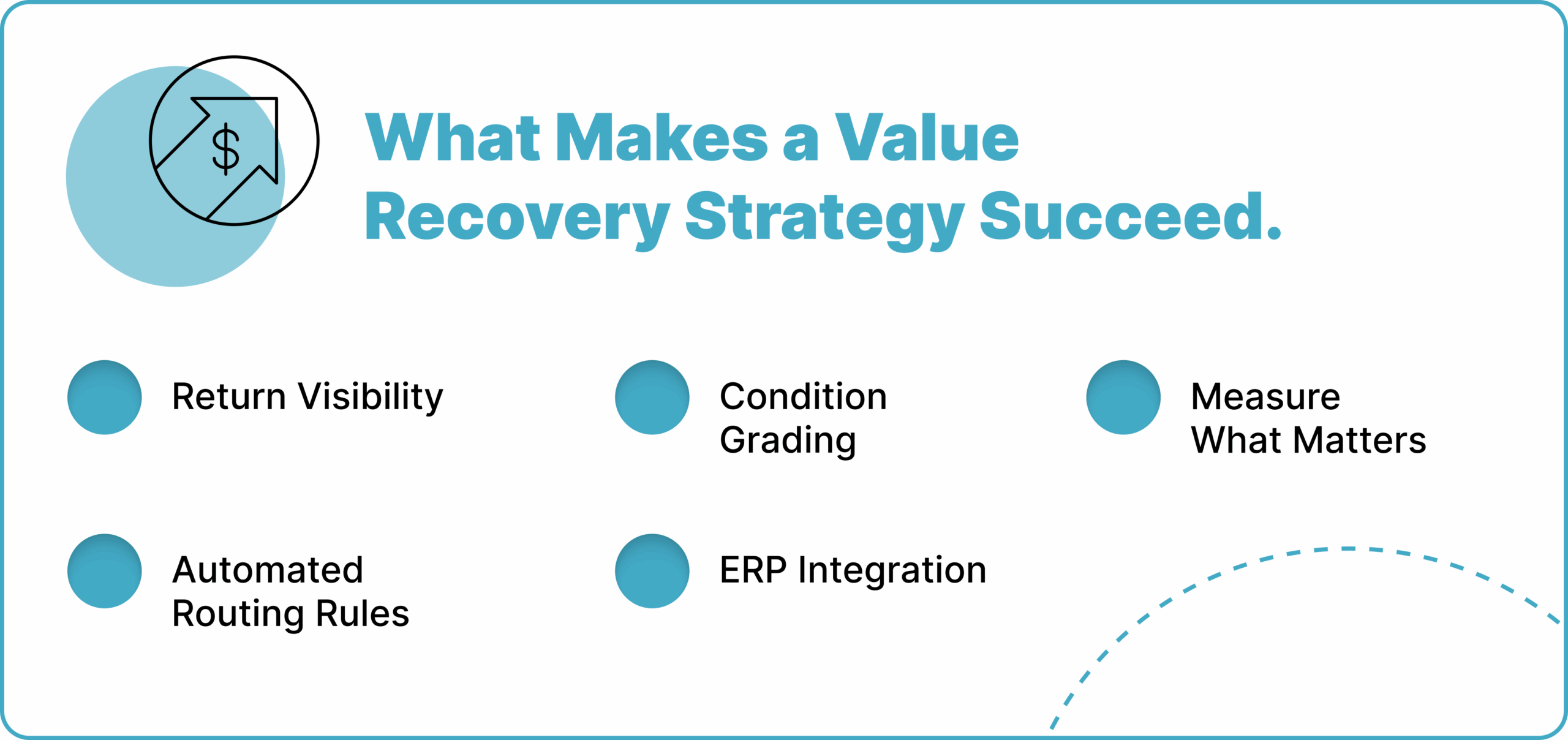How B2B Reverse Logistics Turns Returns Into Assets

Although many distributors are quick to treat returns as a cost they must simply absorb, investing in B2B reverse logistics can make the difference between generating a profit from these returns or incurring a loss and repeating the same cycle.
Article Brief:
- B2B reverse logistics helps recover value through structured refurbishment, redeployment, or resale.
- Companies recover 30–70% of the returned item value when they treat the reverse process like forward logistics.
- With the right process, returns create cost savings, improve customer satisfaction, and support sustainability efforts.
In many warehouses, returned goods sit in a corner, waiting for someone to decide what to do with them. And most of the time, money is lost quietly through storage expenses, damaged packaging, and write-downs.
However, there is an alternative approach that involves converting those returned products into recovered value. And this article explains how distributors can shift from loss control to asset recovery by utilizing refurbishment, redeployment, and secondary market resale. Although the approach is simple, it is not common, and distributors who act early in the return process often recover margins, reduce waste, and improve customer satisfaction simultaneously.
B2B Reverse Logistics Works Differently Than Retail Returns
In retail, returns are quick and happen in high volumes, so, for example, a shoe may be returned because it didn’t fit. When such a situation occurs, the product is typically scanned, sorted, and placed back into inventory or sent to liquidation.
In B2B distribution, the situation is different. You may be handling pallet-level returns, damaged packaging on equipment, surplus goods, custom-made items, or components pulled from the field. These items carry a higher unit cost, and the return process involves contract terms, warranty rules, and often inspection.
That means the reverse logistics process cannot be treated as an afterthought. And if you handle returns manually, you risk losing revenue, experiencing slow warehouse management response times, and wasting labor time. That is why the goal is not just to move goods through the reverse supply chain but to understand where value still exists and then route the returned item to the right outcome.
When distributors track returns carefully and evaluate each returned item for future use, they transition from viewing returns as money losers and trying to prevent them to welcoming and turning these returns into assets.
How the Returns Lifecycle Creates Opportunities to Recover Value

The return process isn’t just a single event. It is more like a chain of events where each one plays a key role in determining if the value is lost or saved. Managing returns means controlling each stage so goods don’t disappear into storage or scrap piles.
1. Return Initiation
Every return request begins with a reason. It could be due to overstocking, shipment errors, warranty replacement, or expired demand, all of which are common causes. However, the reason code matters because it shapes the next move in the returns process. For example, surplus packaging damage is very different from internal part failure.
2. Receiving and Sorting
Returned items must be checked in and sorted by condition. But it is necessary to note that the faster the sorting process, the faster you can route the asset. Many companies lose out here because instead of getting started on the sorting process, they leave the items to pile up and take their time before undergoing inspection. This is dangerous because value is eroded, and the longer it takes, the greater the risk.
3. Assessment & Asset Recovery Decision
This step is where decisions such as whether the item should be refurbished, redeployed, resold, or scrapped are made. A technician, inspector, or automated rule can make this decision. A company can choose whether to refurbish or resell, redeploy within the network, sell as second-hand or used, or recycle materials.
Three Practical Ways to Turn Returns Into Assets
There are three generally accepted ways of turning returns into viable assets, which are currently leveraged by stakeholders across various industries, including telecom, industrial parts, and consumer electronics.
1. Refurbishment for Resale
Refurbishment typically refers to restoring an item to its original condition, making it ready for sale again, and this usually involves cleaning, part replacement, testing, or repackaging.
For example, say an industrial distributor receives returned power tools with minor wear and tear. After testing and replacing a battery, they can repackage the product and sell it at a slight discount to contractors. The tool is safe, and the margin is still positive.
Refurbishment works best where product value is high, replacement parts are readily available, and buyers are willing to accept repackaged goods. Even Apple is famous for earning billions from certified refurbished iPhones. The same idea applies in distribution.
2. Redeployment Within the Distribution Network
Redeployment moves returned goods to where demand still exists, which means that instead of selling, you reassign the returned item to another warehouse, branch, or customer order. For example, a distributor receives 200 returned valves because a project ended early. Say another region in the network has an open order for the same model. Instead of reselling them, the warehouse transfers the returned goods directly to the region that needs them.
The result is no waste, no resale handling, and no shipping costs beyond internal transfers. But it works well when your organization has multiple stocking points.
3. Secondary‑Market Resale
There are situations where some items hold value even when they can’t be sold in the primary channel. When that happens, the solution is usually for the item to be sold in the secondary market, which includes outlet channels, liquidation partners, online B2B exchanges, and auctions, as well as industry resellers.
For example, if a technology distributor can sell refurbished network switches to certified secondary network dealers with an adjusted and disclosed warranty. That way, the distributor also earns revenue that would have otherwise been lost. Secondary markets often require careful brand protection, but the benefits are substantial.
What Makes a Value Recovery Strategy Succeed

To turn B2B reverse logistics into revenue, companies need a structured approach. But the biggest barrier is not technical; it’s operational follow‑through. Here are the enablers that make it work:
1. Return Visibility
You must be able to track returns: what arrived, when, condition, and next action. Many companies use RFID tags, return center dashboards, or integrated warehouse management software.
2. Automated Routing Rules
The system should automatically direct returned goods to the correct path. For instance:
- If condition = Open Box → move to refurb station
- If condition = Unopened → restock
- If condition = Damaged → repair or recycle
Automation lowers warehouse handling time and reduces waste.
3. Condition Grading
Inconsistent grading is why returns pile up, but standard grading stops guesswork. Clear grades accelerate resale or redeployment.
4. ERP Integration
Your return process should update inventory management, financial data, and order records automatically to prevent errors.
5. Measure What Matters
Track these key performance indicators:
- Days to disposition
- Value recovered per return
- Percentage of returns resold vs. scrapped
Measurement enables the return process to become a continuous improvement process.
Returns Are Not Waste With ReverseLogix
B2B reverse logistics can change how distributors see product returns. And when distributors treat returned goods as assets, not problems, the result is a higher margin, reduced waste, and stronger customer expectations. Returns have value, and with ReverseLogix, you have a platform dedicated to helping you recover it. Get a demo today to see how we can help.
Frequently Asked Questions
B2B reverse logistics refers to the process of managing product returns in business-to-business supply chains to recover value or reduce losses.
Distributors can repair, repurpose, or resell returned items through structured returns management and asset recovery workflows.
Common examples include refurbishing equipment for resale, redeploying inventory across branches, or selling through secondary markets.
Companies utilize return centers, ERP integration, and condition grading to manage the reverse flow and minimize inefficiencies in handling returns.
Benefits include cost savings, reduced waste, improved customer satisfaction, and stronger warehouse management across the supply chain.